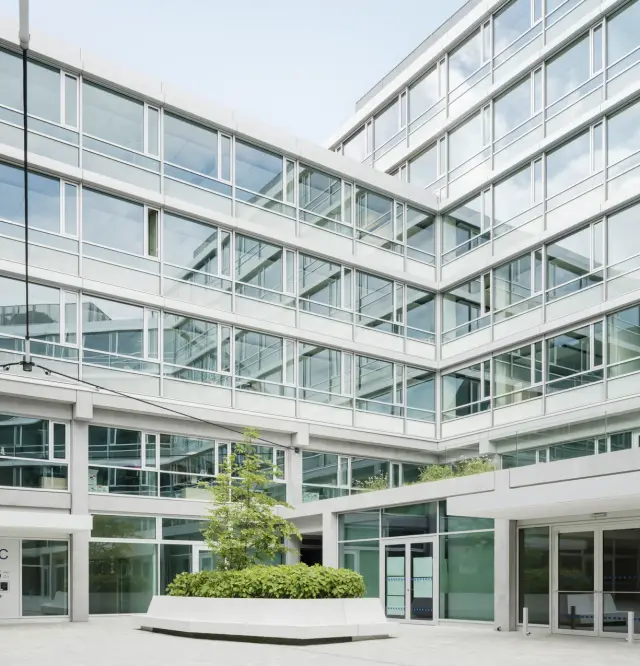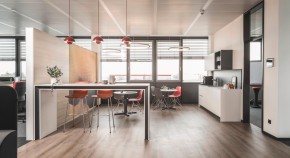
Synergy of function and design New Courts office building, Berlin
- Back
- Home
- Services & Tools
- References
With the campus-like New Courts office building, welter+welter architekten BDA have sensitively recreated a new Berlin block structure with DGNB Gold certification. Its delicate all-glass facade is shaded by a WAREMA window awning with an aluminium vapour coated exterior that envelops the building in a silvery shimmer.
The five- to seven-storey New Courts building on Gerichtstraße in Berlin-Wedding redefines the previously lacking spatial boundaries with its meandering form: welter+welter architekten placed the five-part structure in the open space (previously used as a car park) like a horizontal “S”. The building parts respond to the surrounding development in both height and depth and create a variety of intermediate spaces. Three new courtyards have been created, among other things, some of which are used for deliveries to the building behind.
The thoroughfares required for this have resulted in a light, floating structure that has clear edges while remaining permeable. This motif is replicated in the glass facade that, depending on the weather, reflects and appears to merge with the adjacent city park.
Functional metal insert for visual protection
Flexibility was one of the greatest challenges in this project. The almost 20,000-square-metre office space was originally intended for variable use, accommodating both large and small office units as well as co-working spaces and other modern office concepts. The facade therefore needed to be correspondingly versatile and equipped for all conceivable layout variations. This later turned out to be unnecessary when a government authority moved in and requested that the majority of the building be comprised of traditional cubicle offices and communal meeting spaces.
Instead of the usual office grid of 1.35 metres, the owner and developers agreed on a generous facade division and double the usual grid dimensions. This means there is only ever one opening in the now 2.70-metre-wide glass elements. For the railing elements, an extended aluminium mesh was set into the space between the panes of insulating glass that reflects the thermal radiation at floor level and offers semi-transparent visual protection. The view and perspective change depending on the angle.
The vertical positioning of the extended metal honeycombs is a combination of functional and design goals: the interplay of views depending on where you are standing was absolutely necessary, as was the play of light conjured on the facade by the interior and exterior lighting.
In our office, we always try to combine function and design as much as possible, or to harness synergies
Philipp Welter, welter+welter partnerschaft von architekten mbH BDA, Berlin
Sun shading fabric with synergy effect
Uniting functionality and design is also key when it comes to sun shading systems. It quickly became clear that an external sun shading system was needed that doesn’t just offer the glare control required by law, but can also reduce solar thermal radiation by harnessing building physics.
WAREMA SecuTex A2 fabric came into play due to the need for a staircase facade suitable for fire protection in which all components had to fulfil building materials class A2. The fabric, certified non-flammable in accordance with DIN 4102-A2, is made up of a silicone-coated glass-fibre fabric with no poisonous or dangerous chemicals added.
This means that in the event of a fire, no poisonous gases are emitted and smoke development is minimal. Unlike other textile sun shading products, this fabric does not act as an additional fire accelerant, and prevents life-threatening smoke inhalation.
WAREMA SecuTex fabric can be used flexibly both inside for roller blinds and outside for window awnings. The fabric is aluminium vapour coated on one side and has a reflective surface.
“We opted for a neutral, light grey tone on the room side and placed the aluminium side on the outside. This allows us to maximise heat reduction while also protecting against fire and enhancing the visual effect: when the sun shading is closed, the entire building is enveloped in a silvery shimmer” Philipp Welter enthuses.
Testing window awnings in a wind tunnel
After considering the structure’s susceptibility to wind, the architects decided not to use the awning variant originally planned. A thorough simulation was carried out beforehand by placing a building model in a wind tunnel. The evaluation returned a reduced wind threshold value for the tilted awnings, meaning they were retracted at relatively low wind forces.
Together with the facade planner, the architects therefore chose sun shading fitted tight against the building with front-mounted awnings and lateral easyZIP guidance from WAREMA, which is extremely wind-stable. The complex building geometry also required the variously oriented facade parts to undergo a shading test. The window awnings on the purely north-facing facades were therefore replaced with interior anti-glare blinds in the same silver-coloured fabric, a welcome reduction in cost.
The ceiling connection of every window is fitted with a device to manually operate blinds, allowing easy retrofitting where necessary. This flexibility – including sun shading – was an important criterion when the building received Gold certification from the German Sustainable Building Council (DGNB).
Window-specific sun shading control system
Automatic sun shading control was part of the plan from the early stages.
The facade planners, architects, developers, control system planners and experts from WAREMA worked together to come up with the most functional and economic concept that meets all requirements. This allowed all project participants to find the most flexible control solution for optimal user comfort.
The sun shading ensures thermal comfort for users all year round; it helps stop the sunlight from heating the building in the summer and keeps the warmth inside in the winter.
Three questions for the facade planner
Three questions for facade planner Andreé Franke, IBF Ingenieurbüro Franke GmbH & Co.KG and member of UBF (Unabhängiger Berater für Fassadentechnik e.V.)
These days, the facades of office and commercial buildings in particular need to be designed to offer the greatest possible daylight usage and summer heat protection and – above all for office workspaces – to offer comfort when you’re working at a screen. A facade planner should be engaged during the design stage so that technical engineering questions can be clarified at an early stage. The technical features of sun shading systems have a great impact on the facade, but so do fire protection requirements and wind susceptibility, which can significantly influence the architectural design. Expectations for comfortable use – such as automated guidance of external venetian blind slats according to the position of the sun, or the integration of room temperature control – can also be incorporated into the early planning stages.
The necessary wind threshold values should be determined by a wind test, particularly for complex building geometries with very different wind loads on the individual facades. The distance between the fabric and the facade structure is important when defining the wind values. Any lateral ventilation will reduce the wind threshold value. Therefore, the results of the wind simulation have a significant impact on the specific design of sun shading systems and should be performed early in the planning stage. This is particularly important if the use of sun shading is included in the calculation of the building’s energy footprint. A wind simulation is also required to determine the number of wind sensors or a potential reduction in the number of sensors.
The planned rental concepts are of the highest importance when it comes to controlling sun shading systems. Large rental spaces should generally be controlled from a central point. Window-specific control is more expensive, but it does help to prevent arguments among users and enables flexible usage concepts. We must also remember that the use of a building may change, and take into account the impact this would have on the control concept. Expected user problems and their potential effects should therefore be considered in the collective deliberations of the project participants during the design phase.
Construction details
- Project: New Courts office building
- Location: Gerichtstraße 48 – 49, 13347 Berlin
- User: Government authority
- Developer: Gerichtstraße 48 – 51 GmbH, Berlin
- Architect: welter welter partnerschaft von architekten mbH BDA, Berlin
- Facade planning: Ingenieurbüro Franke GmbH & Co. KG, Berlin
- Completion: 2023
- Certification: DGNB Gold
- Sun shading system: WAREMA front-mounted awnings with easyZIP guidance, size 130, with WAREMA SecuTex A2 fabric; cassette roller blind L and bracket roller blind L with WAREMA SecuTex A2 fabric
- Control: WAREMA LON® control with sensor unit, photo/radio clock sensor, wind/photo sensor, precipitation sensor, outside temperature sensor, motor control units, I/O modules, touch panel, logic for implementing wind evaluation, project-based planning, commissioning, application of wind evaluation, annual shading
Discover the central hub for your digital planning: myWAREMA offers a variety of interactive planning aids, drawings, tender specifications, comprehensive product documentation, and a project view for managing your planning components – all to design your projects effectively and professionally.
Your direct contact to us

Hotline for architects





